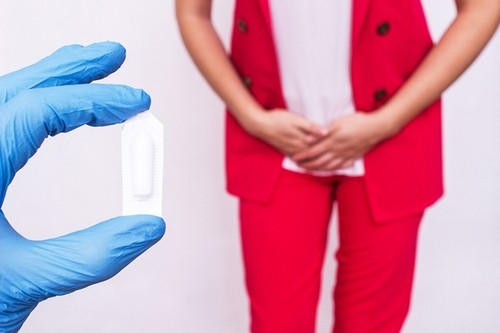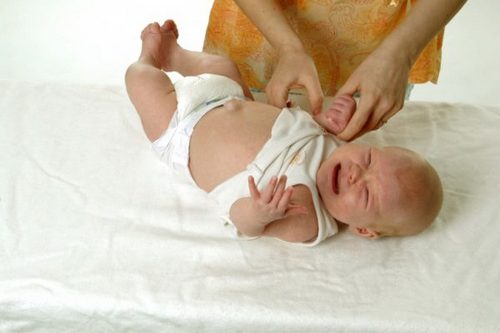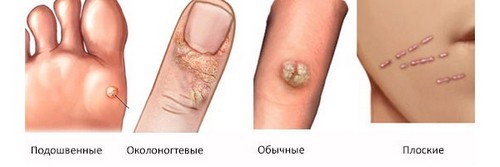Imagine a cute kid splashing vigorously in an already half-empty bath, a calm river or a swimming pool “populated” with toys before his arrival. This mesmerizing scene is sure to cause your genuine emotion.
For a child, such a joyful experience is equal to receiving a mass of positive emotions.
In this context, it is important to remember that the love of children for water is formed at a very young age, determining the desire of young parents to pay special attention to the process of bathing a newborn.
When to start?
Most pediatricians advise the first bathing of the newborn after healing the umbilical wound. It will be a mistake to bathe the baby immediately after discharge from the hospital, because in this case you will expose immature childhood immunity to the fight against infections from tap water, including boiled water.
At first, the baby’s hygiene should be provided with wet wipes, sponge dampened with water or cotton swabs, paying particular attention to washing and washing. Full bathing of the baby is possible at the age of 2-4 weeks.
Where and in what to bathe?
Alternatives to bathing a newborn baby include a regular adult bath and a special baby bath. The second option will be the preferred choice, because this convenient device has a number of significant advantages. First of all, in the event of a seasonal lack of hot tap water, you do not have to boil it in buckets.
A teapot of water will be enough to fill the bath. In addition, babies often suffer from various skin diseases, including allergies, erythema, diathesis. In these conditions, bathing a newborn is recommended in a decoction of medicinal herbs, which can be spent much more economically using a small baby bath.
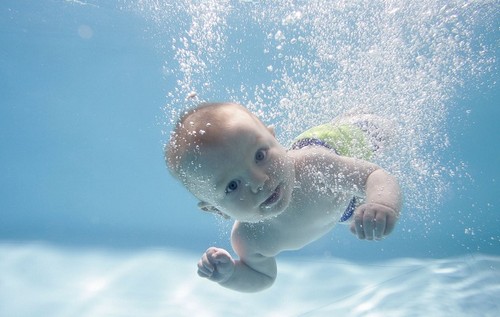
Various devices are available on the modern market to maximize the hygiene of nursing sons and daughters. You can purchase a bath with a wide rim that clings to the sides of a regular bath and frees you from having to bend too much. Another assistant can be a slide for swimming, which supports the baby on the surface of the water.
Bathing a newborn in a large bath or small bath should be carried out in the most clear water. If the quality of tap water in your city leaves much to be desired and poses a risk of any infection, it is better to take boiled water. Her softening can be done with herbs or sea salt. Some parents prefer using bottled water.
The temperature of the water used should be 35-37 ° C, depending on your desire to combine hygienic sessions with hardening and healing. From time to time, you can bathe the baby in herbal infusions (not more than 1 time per week). Potassium permanganate for bathing newborns in the form of a pale pink solution is usually used before healing of the umbilical wound. It is important to remember that it dries the skin of the baby very much.
The thermometer column in the procedure room should be kept at 26 ° C. If you are washing in the bathroom, do not close the doors. This will create a sharp temperature difference when it gets from the place of water procedures into the room and can trigger a cold. In addition, sometimes tap water contains a huge amount of chlorine, the inhalation of which certainly will not bring the baby any benefit. Doors should only be closed when there are drafts.
How often do you need to bathe your baby?
Bathing a newborn baby with detergents should be done no more than twice a week. To keep your baby clean, this will be enough. Most types of soaps and gels adversely affect the skin of infants, washing off the protective lubricant and causing it to dry. Washing too often with detergents creates excessive sterility, resulting in an allergy to the baby.
The frequency of water procedures should be increased to daily splashing when the baby begins to crawl. In this period it is permissible to wash it and once every two days.
In the hot season, bathing should be carried out more often than in cool weather.

Time and duration of water procedures
Usually young heirs are washed in the evening, before the last feeding, but this tradition is not considered the norm and parents can independently choose a suitable time for their child and convenient time for water events. To do this, you need to monitor the level of activity of the baby before and after taking a bath.
If washing overexcites the baby and makes him playful, he will not be able to fall asleep. In this case, the procedure is recommended in the morning. Some guys have a better bath after eating, others prefer washing on an empty stomach. Someone likes to dabble before bedtime, someone – after waking up. This has nothing to do with the vagaries of your baby and is determined by physiological characteristics that dictate the rhythm of his life.
The optimal time spent in water is 10-15 minutes.
Detergents
Bathing a newborn in a large or children’s bath requires the use of high-quality detergents that will not affect the baby’s health. Today on the shelves of specialized stores you can find all kinds of cosmetics to ensure the comfort of the smallest.
When choosing shampoos, gel, soap or foam for your crumbs, pay attention to such important indicators:
- Structure. Carefully study the labels of purchased goods for the presence of prohibited substances in their composition. In particular, this applies to preservatives, bright dyes and biological additives. Avoid bathing products for babies with a bright color or smell. Do not buy products with antibacterial components, because these substances violate the natural microflora of the skin of the child.
- Additives. For representatives of the younger generation, prone to allergies, you do not need to buy products with herbal extracts. For children who are not prone to allergic reactions, products with extracts of lavender, chamomile or a string are a good choice.
- PH level. There is a misconception that the pH should be equal to 5.5. In fact, this figure is valid for adults with a neutral pH level, but not for infants whose pH is moderate and 6.8. Therefore, in the first few weeks of a child’s life, it is undesirable to bathe with a pH-neutral product.
What else will you need?
You, as a responsible parent, need to stock up in advance with all the things that may be needed in the process of washing the baby. In addition to the baby bath and children’s detergents, this necessarily includes a bath thermometer that will help you navigate the temperature conditions of the procedure, as well as relieve children’s cries and tears when the baby is immersed in too hot or cold water.
You will also need a terry towel. If you have the opportunity, get a towel with a corner-hood, which is worn on the head and allows you to completely wrap the newborn after bathing.
Washing is best done using a piece of terry towels or terry mittens. Your hand may also serve as a washcloth. To rinse the crumbs, stock up on a small bucket.
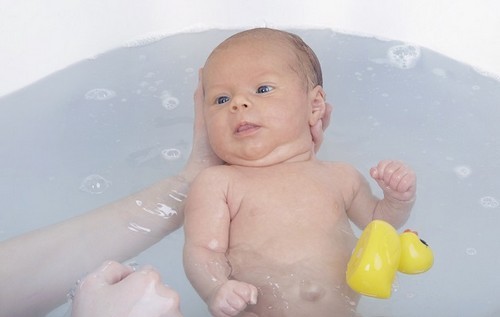
Bathing a newborn in a large bathtub can be carried out with an inflatable circle. This swimming aid helps to maintain its head above the water level and does not limit the freedom of movement of arms and legs, which ensures the baby is safe from flooding and does not affect its activity. Read more about what a good circle for bathing a newborn is →
In any bath you can use the bathing slide already mentioned in the article.
To ensure hygiene of the eyes and ears of the baby, you need to buy cotton pads. Prepare a new diaper, powder and clean clothes in advance.
The sequence of basic procedures
The algorithm for bathing a newborn baby is reduced to the following principles:
- Remove rings, bracelets, watches. Wash your palms and the back of your hands thoroughly with soap and water.
- Undress the child in the water treatment room a couple of minutes before bathing to give him the opportunity to get used to the ambient temperature.
- Perform a gymnastic warm-up and massage, which in total should take no more than 10 minutes.
- Fill the bath or bath with water and carefully place the baby in it, not forgetting to talk or sing a song with it. Before immersing in water, it is recommended to wrap the child in a diaper so that unfamiliar sensations of contact with the new environment do not scare him. The diaper will get wet gradually and ensure a smooth process of adaptation to water.
- Lather the baby with soft circular motions in the direction from the neck to the legs and rinse off the foam. The newborn should wash his hair last, protecting his eyes from foam.
- Rinse your baby with slightly cooler water.
- Remove the baby from the bath and wrap it with a towel.
After swimming
After bathing, a newborn should not be wiped in the usual sense of the word. His skin is very delicate, and such manipulation can be fraught with unpleasant consequences. It is recommended to remove excess moisture from the child’s body with the help of light, delicate movements. First you need to get your head wet, and then the body.
Pay particular attention to creases where moisture can remain. After the wrinkles are completely dry, use cosmetics as needed. Apply powder in the area of diaper rash. The cream will save the baby’s vulnerable skin from dryness. Avoid applying powder to the cream – lumps are formed, rubbing the skin of the newborn.
Never use a hair dryer to dry your baby’s hair. The hair of the baby should be carefully combed with a brush and comb out the scales. They are perfectly removed provided that baby oil is applied to the skin of the head of the baby before the bathing procedure.
You can take cotton pads or tampons to get your newborn’s ears wet. Ears should be cleaned so as not to affect the auditory canals. The baby’s eyes need to be cleaned with sterile cotton wool, moving from the outer edge to the inner to prevent infection. The newborn’s nose is cleaned using cotton wool flagella.
Now the baby can be dressed or swaddled. Debatable is the need for a bonnet after water procedures. You can put it on the baby when the temperature in the room is not very high, or do without it in conditions of warm temperature.
What is the use?
Bathing a newborn has many advantages and is not limited solely to ensuring its hygiene. So, the procedure tempers the baby’s body and makes it spend a lot of energy, which positively affects the dynamics of its growth, improves sleep, increases appetite, strengthens the vestibular apparatus and becomes the basis of early physical development. Bathing promotes cleanliness and relieves the child of a number of possible diseases, especially of an infectious and allergic nature.
Water has a beneficial effect on the nervous system. As experience shows, it can help to relax and calm even the most excited children. A humid environment cleans your baby’s airways.
Bathing a newborn boy or girl means establishing close bodily contact with them. This helps to establish an emotional bond between the parent and the child and is a particularly valuable aspect when spending a significant part of the parent’s day at work. When bathing a child, be sure to do it confidently and without fear, because he very subtly feels all the facets of your emotions.
If you want to know what the optimal bathing process should be, you can always find dozens of videos on how to bathe a newborn baby on the Internet. Be informed about the correct approach to washing your baby and let your child get the maximum benefit and pleasure from any water procedures. Good luck

